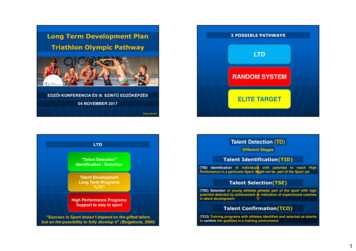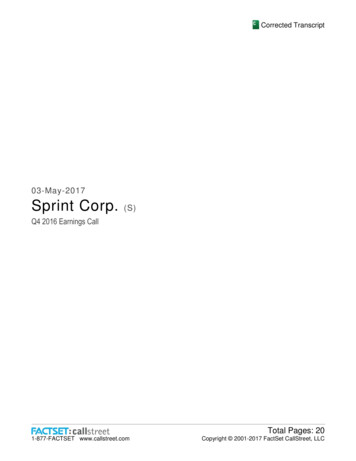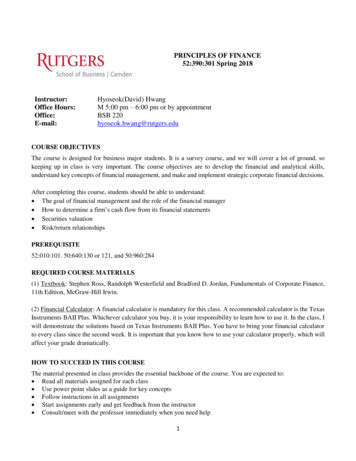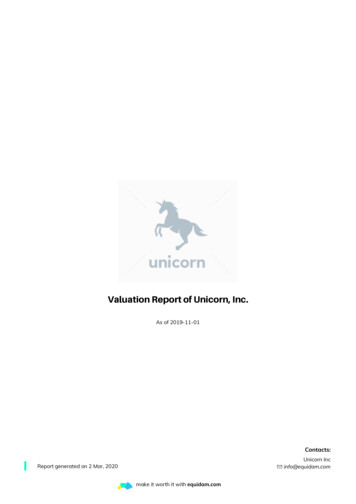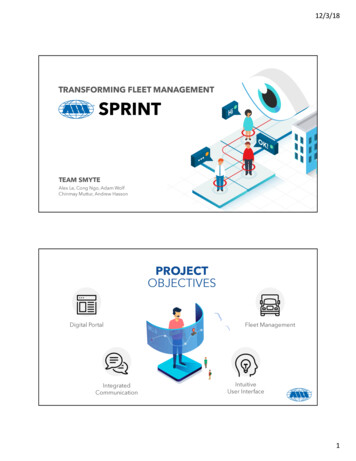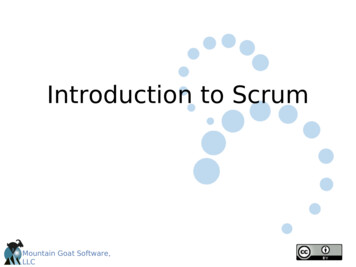
Transcription
Sprint CorporationValuationApril 1, 2005Andrea Armentaarmenta a83@yahoo.comBrianne Braudtangelgirl125@juno.comDavid Dencklaud dencklau@hotmail.comKent Ewaltkewalt@cox.netMatt Milatonimjmilantoni@aol.com
Table of ContentsExecutive Summary . . . 3Business & Industry Analysis. .6Company Overview . .6Five Forces Model . .6Competitive Strategy Analysis . 9Accounting Analysis .11Key Accounting Policies .11Potential Accounting Flexibility .12Strategy Analysis .12Quality of Disclosure .13Potential Red Flags .14Ratio Analysis & Forecast Financials 17Ratio Analysis .17Forecasting the Financial Statements .25Valuations Analysis . . .29Method of Comparables . .30Discounted Dividends . .33Cost of Equity . .33Discounted Free Cash Flows . .35Cost of Debt .35Weighted Average Cost of Capital . 36Discounted Residual Income . . 37Abnormal Earnings Growth .38Long Run Average Residual Income Model . .39Z-Score .39Conclusion . 40References .41Appendix 422
Executive SummaryPlan forParadiseAnalysis of Sprint CorpEvaluators:Investment Recommendation:NYSE: FON52 week price rangeRevenue (2004)Market CapitalizationDEBAM Investment GroupAndrea Armenta, Brianne BraudtDavid Dencklau, Kent Ewalt, Matt MilantoniDate of Valuation: April 1, 2005Sell 22.74 16.83 - 25.8027.43 Billion34.78 BillionEPS ForecastFor the 0090.50SprintShares Outstanding1.48 BillionDividend Yield3-month Avg Daily Trading n Ratio ComparisonTrailing P/EN/A13.53Forward P/E14.9614.35Forward PEGN/AN/APercent Institutional Ownership80.58%M/B2.482.21Book Value per ShareROE (2004)ROS (2004) 9.17-7.67%-3.69%Valuation EstimatesCost of Capital Estimates12,555,40920100.74BetaActual Current Price (April 1, 2005)KeKe Estimated 22.74Ratio Based ValuationsP/E Trailing21.765-year Beta1.3578.158%P/E ForwardN/A3-year Beta1.8989.781%PEG ForwardN/A2-year Beta0.8206.547%Dividend Yield9.36Published Beta1.3428.113%M/B20.26Epic onsDiscounted DividendsFree CashFlowsResidualIncomeAbnormal Earnings GrowthLong-Run Residual Income Perpetuity6.2059.2613.5613.8520.67320131.62
Sprint Corporation is in the business of global communications for both residential andbusiness customers. They are comprised of two divisions: Sprint PCS, a 100% digitalwireless communications service, and Sprint FON, the number one local fixed-lineprovider next to the Baby Bells. Between these two divisions, Sprint offers long-distance,local, and wireless communication services to its customers on local, national, and globallevels.Sprint currently has a market cap of 34.78 billion. In 2004, they had revenues of over 27billion but ended up with a net loss for the year of 1 billion. This follows net income of1.3 billion in 2003 and .6 billion in 2002. Although Sprint was able to increase itsrevenues in 2004, offsetting increasing in expenses and the lack of nonrecurring incomeitems found in 2003 and 2002 resulted in a net loss for the company.Sprint competes in a fairly competitive environment. Rivalry among existing firms ishigh, fueled by increasing concentration as more and more telecommunications providersmerge and low switching costs for customers. Sprint also must be aware of the threat ofsubstitute products. For its FON division, this comes from the growth of the mobilephone industry. For its PCS division, this comes from the increasing use of the Internetand e-mail to communicate as well as from high-speed internet phone companies such asVonage. On the other hand, the threat of new entrants is relatively low due to large startup costs and the bargaining power of both buyers and suppliers is low consideringSprint’s size.Sprint competes by differentiating itself from its competitors. Sprint’s main strength isits ability to provide customers with tailor-made solutions by combining its wireless, wireline, local, long distance and global services. Sprint’s key success factors include itsemphasis on innovation of service alternatives, customization of business solutions,cutting edge products and services, and cost efficiency.In evaluating Sprint’s accounting policy, we found that Sprint is fairly conservative in itschoice of accounting methods. We also found that the quality of disclosure for Sprint ismoderate. Although some information was aggregated, Sprint was open about presentingboth bad and good news with its shareholders. Sprint’s website2 proved a clear and easyto use source of information. Overall, we feel that Sprint provides the informationnecessary for investors to make an appropriate analysis. We also computed sale and coreexpense manipulation ratios for Sprint and two of its competitors. We found that Sprint’sratios tended to be similar to those of their competitors. Based on our research, we feltthat Sprint’s financial statements were accurate and did not need to be restated.We forecasted the financial statements of Sprint Corp for the next ten years usinginformation from the prior five years. We used pro forma financial statements of the pastfive years as well as liquidity, profitability, and capital structure ratios to identify trendsin computing our forecasts. After considering Sprint’s sustainable growth rate, averagegrowth rate, and other analysts’ opinions5, we calculated that Sprint’s revenue will growat 3.2% per year. This results in revenues of 37.5 billion in ten years. Based on our4
forecasts, we believe Sprint will grow, but only very slowly because they are not able totransfer much of their revenues to their bottom line. Forecasted net income in ten years isonly 1.1 billion out of 37.5 billion in revenue.Finally, we valued Sprint using multiple valuation models. Using the method ofcomparables produced mixed results. The forward P/E, Market to Book, and Price/Salesratios came closest to Sprint’s observed price of 22.74. Three of the four intrinsicvaluation models (discounted dividends, discounted residual income, and abnormalearnings models) resulted in Sprint being overvalued. The discounted free cash flowsresulted in Sprint being undervalued by nearly 30. This is clearly an outlier and wasdiscarded. The discounted residual income model and the abnormal earnings growthmodels both found that Sprint is overvalued by around 8.00.We computed a cost of equity between 6.5% - 9.7% and a cost of debt for Sprint of 5.1%.This results in a weighted average cost of capital of 6.1%. Clearly, our valuation willchange based on which cost of equity is used. We performed a sensitivity analysis foreach valuation model to see the effect of changes in the cost of capital and the growthrate assumed for each model. Even allowing for these changes, we still found that Sprintwas overvalued. Given our in-depth analysis and countless man-hours of research, webelieve that Sprint is overvalued and recommend it as a sell.5
Business and Industry AnalysisCompany OverviewSprint Corporation specializes in global communications for residential and businesscustomers. Among their services are long-distance, local service, and wirelesscommunications. Sprint Corporation is comprised of two divisions: Sprint PCS, a 100%digital wireless communications service, and Sprint FON, the number one local fixed-lineprovider next to the Baby Bells. The FON Group includes Sprint’s global marketdivision, local division, and other business activities, including wholesale distribution oftelecommunication products and operation of a transatlantic Tier 1 internet backbonenetwork. The purpose of this report is to analyze Sprint Corporation in relation to itscompetitors in the industries in which it operates. We first analyze the industry using theFive Forces Model and then discuss Sprint Corporation’s competitive strategy.Five Forces ModelThe Five Forces Model provides a framework for analyzing the potential profits in agiven industry. The factors that affect profitability include the degree of actual andpotential competition, as measured by the rivalry among existing firms, the threat of newentrants, and the threat of substitute products, and the bargaining power in input andoutput markets, as measured by the bargaining power of buyers and the bargaining powerof suppliers. We discuss each of these factors for Sprint Corporation in the next severalpages.Rivalry Among Existing FirmsRivalry among existing firms is determined by several factors, including industry growth,industry concentration, the level of differentiation, switching costs, scale and learningeconomies, excess capacity, and exit barriers. We discuss each of these individually.Industry GrowthThe wireless communications industry has been growing quickly due to the increasingneed for mobility. Switching from analog to digital wireless networks has alsoencouraged the rapid growth. However, with competition increasing and new customersubscriptions declining except in underdeveloped nations, price competition is becomingmore prevalent. Wireless internet access may provide an important opportunity foradditional growth in the industry.6
In the fixed line industry, deregulation in the form of the Telecommunications Act of1996 has opened the door for anyone to offer service. Growth in this industry has slowedwith the increase of wireless communications as services like the internet and e-maillessen people’s reliance on fixed line communications. With more than 90 million milesof fiber-optic cables constructed by U.S telecom companies across the nation with up to90% unused capacity, there is plenty of opportunity for the industry to meet futuredemand growth for services such as broadband communications.ConcentrationThe Wireless industry is dominated by several merged companies including VerizonWireless (Verizon and Vodaphone Group), Cingular Wireless (SBC Communications,Bell South and recent acquisition, AT&T Wireless), and Sprint PCS. As a result ofderegulation in 1996, there are now many smaller players in the telecommunicationsindustry. Verizon Communications, SBC Communications, Bell South and QwestCommunications International are the four “Baby Bells” that still dominate local phoneservices and the roll out of DSL broadband access. With just few major companiescontrolling the majority of the telecommunications industry, prices are not as low as theywill become as more competition develops in the future.Differentiation/Switching CostsWith the major carriers of wireless and telecommunication companies using relativelysimilar technologies, there is little differentiation between competitors except for usageplans and equipment styles. The major switching costs in the wireless industry are longcontracts, large penalties for early contract termination, and purchase costs for newhardware. Switching costs for the fixed line telecommunications industry are minimal,consisting of moderate setup fees and hardware costs.Scale/Learning EconomiesThe sheer size and dominance of the major companies in both industries makes gainingany significant market share by newcomers difficult. With billions of dollars spent bywireless companies for third generation licenses and the debt incurred from networkdevelopment, it will be difficult for new entrants to afford to compete in the wirelessindustry.Excess Capacity/Exit BarriersThere is excess capacity in both the wireless and the fixed line telecommunicationsindustries causing price competition to intensify. Also price wars will escalate as it is7
extremely costly to exit the industries given the huge amount of money invested in capitaland Research and Development.Threat of New EntrantsIn the past, the telecommunication industry was very hard to break in to. Now, theTelecommunication Act of 1996 has deregulated the industry. The act was passed to helpstimulate competition and make it easier for new, start-up companies to jump into themix and compete with the big boys of the industry. The large established corporationsstill have the upper hand against new firms entering the market. The industry requires atremendous amount of capital that established corporations already have. New entrantswould find it difficult to raise that capital and compete with the established corporations.Another problem new entrants face is getting licensed, which is costly. This process canalso be very lengthy. The threat of new entrants is a possibility that Sprint Corporationmust consider, but is not a major factor. Sprint has established relationships withcustomers and suppliers that take time to develop. They already have their researchdepartment established and are coming up with new technologies and ideas to stay onestep ahead of their competition.Threat of Substitute ProductsThe FON Group faces a huge threat from the continuing growth of the mobile phone.Cell phones are beginning to take the place of land lines as the primary communicationdevice for most households. In conjunction, the Internet and e-mail are also helping withthe lapse of land line phones. Meanwhile, the PCS Group is Sprint’s bread winner as thewireless communication industry continues to build.A threat to the wireless communication industry comes from the new kid on the block:high-speed internet phoning. Companies like Vonage are potential threats to Sprint PCSbecause with wireless internet you could, in a sense, take your computer with you andalways have a phone to make unlimited calls to anywhere. Some of Sprint’s competitorshave counted on the new idea and are continuing to diversify themselves into this newtechnology. Verizon, for instance, is now offering this new service through what theycall VoiceWing.Bargaining Power of BuyersOverall, the bargaining power of buyers has a low impact on Sprint Corporation. Thebargaining power of buyers is composed of two factors: price sensitivity and relativebargaining power. The price sensitivity of buyers for Sprint’s products varies. On onehand, buyers are very price sensitive for commodities. One example of this is the localand long-distance telephone services provided by Sprint’s FON component. There islittle differentiation among local and long-distance telephone services and switching costs8
are low, so consumers are highly sensitive to price. On the other hand, Sprint has beenable to differentiate its wireless digital PCS network by consistently offering the newesttechnology on the market. Buyers are not as price sensitive for these items. The relativebargaining power of buyers is also low due to the large number of buyers and thegenerally low volume of purchases per buyer. While there are multiple alternatives forbuyers to choose from, the cost of one individual not doing business with Sprint will havelittle impact on the company.Bargaining Power of SuppliersSprint is committed to supplier diversity, but at the same time is also trying to get themost value for its money. Even though many large companies are able to give cheaperprices, Sprint still looks out for the little guys (companies). Sprint is committed toincluding small, third-party certified minority, woman, and disabled veteran ownedbusinesses2. Sprint goes about choosing suppliers by having them register a bid for theproduct or service that they could supply which Sprint evaluates whenever it needs aproduct or service. For example, when Sprint needs to purchase more landlineconnections in Texas they will run a query for all companies that are involved inlandlines. Then they will be evaluated and chosen based on the need of the company andthe price. Seeing the process that Sprint has in place to choose suppliers, it is easy to saythat suppliers have low bargaining power over Sprint Corporation.Competitive Strategy AnalysisThe telecommunications industry consists of many companies. However, the maincompetition in the industry comes from relatively few major firms. The level ofcompetition between these few dominant firms can be intense. In order to achieve acompetitive advantage in the industry, Sprint’s main focus is the strategy ofdifferentiation of its products and services from its closest competitors. Sprintdifferentiates its products from its rivals by developing and distributing state-of-the-artnetwork technologies which include its nationwide 100% digital PCS wireless networkand the first all digital, nationwide award winning fiber-optic Tier 1 internet backbone inthe U.S.To distinguish itself from competitors, Sprint focuses on several key success factors.Among these factors are Sprint’s emphasis on innovation of service alternatives,customization of business solutions, cutting edge products and services, and costefficiency. Sprint builds the foundation for accomplishing its goals by re-aligning itsinternal resources in 2004 to cater to customers of two distinct groups, individuals andbusinesses. Their previous structure was more product-focused. By restructuring, Sprintcan use its assets more efficiently to grow sales, reduce operating costs, increaseemployee productivity, increase innovation, and increase product and servicedifferentiation. In order to remain competitive in the future, Sprint is growing more and9
more toward providing one-stop communications services for all of its businesscustomers and consumers.Sprint’s strategy has been successful to date as their wireless customers have increasednearly 22% and DSL customers almost 60% in 2003. Sprint provides simplicity tobusinesses by providing tailor-made solutions which combine wireless, wire line, local,long distance and global data and voice capabilities, creating solutions across productboundaries in ways that are unmatched by competitors2. Berge Ayvazian, President ofthe Yankee Group, states, “ While other carriers can still compete with bundled servicesthrough wireless partnerships, none of them can achieve the same streamlined efficiencyand focus of which Sprint is capable.” Sprint also forms strategic alliances with severalindustry-leading companies such as Cisco Systems, HP, IBM, and Nortel Networks togenerate innovation and provide top notch customer solutions. Sprint is known for havingsome of the most advanced products and features. They achieve differentiation by being afirst mover in bringing new features and technologies to market.Accounting Analysis10
In this section we use both qualitative and quantitative measures to evaluate the degree towhich Sprint’s accounting and financial reporting capture the underlying business reality.There are six key steps in performing accounting analysis. First, we identify the keyaccounting policies for Sprint and assess the degree of accounting flexibility in thoseareas. We then evaluate Sprint’s accounting strategy and quality of disclosure andidentify any potential red flags. We omit step six, undoing accounting distortions,because we believe that Sprint’s financial statements are reasonable and not distorted.Key Accounting PoliciesKey accounting policies for Sprint Corp occur in the areas of revenue recognition andrelated allowance for uncollectible accounts and accounting for its numerous long-livedassets, including property, plant and equipment, definite life intangibles, goodwill, andindefinite life intangibles. Research and development spending should be a keyaccounting policy because it is directly linked to the cutting-edge products that are one ofSprint’s key success factors. However, we were not able to evaluate this because Sprintdoes not provide any information on R&D spending in their 10-K. This is one exampleof poor accounting disclosure on Sprint’s part.Revenue recognition methods are key accounting policies for Sprint because Sprint relieson revenues to furnish its continued growth. In the current telecommunications industry,the companies that will be successful are those that can provide a variety of servicesthroughout the nation. Recent mergers and acquisitions reinforce the fact that only the bigplayers will survive. Sprint must have adequate revenues to continue to grow, eitherthrough expanding its own structure or acquiring other companies. Accounting forallowance accounts is also important because any changes in them directly affect therevenue recognized for that period.As a telecommunication provider, a significant portion of Sprint’s assets consist of longlived assets. Property, plant, and equipment, net of accumulated depreciation, accountedfor 56% of Sprint’s total assets and net intangibles accounted for nearly 20%, accordingits unaudited third quarter 2004 10-Q. Sprint’s property, plant and equipment consist ofland, buildings, digital fiber-optic network, switching equipment, microwave radio andcable and wire facilities1. Intangibles include goodwill, licenses, patents, andtrademarks1. Accounting for these is especially important to Sprint because changes intechnology or the industry may cause the value of some of these assets, such as the digitalfiber-optic network or goodwill, to drastically change.Potential Accounting FlexibilityThe FASB allows several accounting methods in the areas of depreciation, amortization,goodwill, inventory, retirement benefit plans, and stock-based compensation. The FASB11
allows choices in accounting for these items so that managers can choose the method thatbest fits the underlying economic reality for their company. However, choice of differentmethods will lead similar companies to show different balances for these items, so thereis some room for managers to choose a method that helps them appear more profitablethan an alternative method.Sprint records its property, plant and equipment at historical cost and depreciates theseitems on a straight-line basis over their estimated economic useful lives. This is in linewith common accounting practices. It is also the method used by AT&T4, one of Sprint’scompetitors. Sprint expenses repair and maintenance costs as they are incurred.On January 1, 2002, Sprint adopted the Statement of Financial Accounting Standards(SFAS) No. 142, as its method for accounting for goodwill and other intangible assets1.In line with SFAS No. 142, Sprint stopped amortization of goodwill and indefinite lifeintangibles as of December 31, 2001. They are now on the books at their current carryingvalue, which is evaluated each year for impairment. Definite life intangibles areamortized over their useful lives, which at year-end 2003 averaged 10 years1. Definitelife intangibles are checked for impairment whenever economic indicators suggest that itis necessary.Sprint accounts for its inventory differently for its FON group and its PCS division. TheFON group states its inventories at the lower of cost or market value using the first-in,first-out (FIFO) method. The PCS division states its inventories at the lower of historicalcost, also using the FIFO method, or replacement value. Replacement value willgenerally be lower than market value, so this is a conservative accounting choice.Retirement benefit plans represent a significant cost that will not be incurred until the farfuture. Accounting for these requires management to make numerous assumptions aboutfuture discount rates, return on assets, and health care costs. Sprint makes theseassumptions based on historical experience, benchmarks, and assumptions from anindependent actuary. On January 1, 2003, Sprint began accounting for stock-basedcompensation using the prospective method outlined in SFAS No. 123 and No. 148.Under the prospective method, Sprint expenses the fair value of stock-basedcompensation made on or after January 1, 2003.Strategy AnalysisAfter examining Sprint’s financial statements in depth, we believe that Sprint takes amoderately conservative approach to accounting for its segments. This is illustrated inseveral ways.First, Sprint recognizes its revenues as services are rendered or products are delivered inaccordance with SEC Staff Accounting Bulletin No. 104. Revenues received for bundledproducts are allocated among the different items based on relative fair values. This is inline with its competitors. Sprint recognizes expenses as incurred. They have also adopted12
SFAS No. 123 and No. 148 in accounting for stock-compensation plans, which requiresall stock-compensation to be expensed at fair market value. This choice of accountingmethod will increase Sprint’s expenses and reduce their bottom line. Sprint also regularlyevaluates its assets for impairments.On the other hand, Sprint chooses to value its inventory using the FIFO method for bothdivisions. During periods of increasing inflation, the choice of the FIFO method will leadto lower costs, which will lead to increased gross profits. Also, in any company in anyindustry, managers are evaluated on the overall profitability of the company. There willalways be some incentive for top management to make choices that will increase thebottom line of their company. However, we have not identified any serious areas wherewe believe that Sprint has manipulated its numbers or taken advantage of aggressiveaccounting methods.Quality of DisclosureThe quality of disclosure for Sprint is moderate. Sprint is open about sharing both badand good news with its stockholders. Sprint does disclose its significant accountingpolicies and provides information on its different segments. However, some informationis difficult to find and other information, such as R&D spending, was not presentedseparately, making it impossible to evaluate.In examining Sprint’s financial statements, the company provides detailed informationabout the recent consolidation of its two core divisions, the FON group and the PCSdivision, into a single stock under the ticker symbol FON. It explicitly covers what theconsolidation means to both sets of previous stockholders.Sprint had to reissue its 10-K for 2003 due to a calculation error discovered in the fourthquarter of 2003. This error resulted in the overstatement of interest capitalized during theconstruction of Sprint’s wireless capital assets, with a corresponding understatement ofinterest expense and overstatement of depreciation expense. According to Sprint, thecumulative impacts of this error as of June 30, 2004, including the related income taxeffect, resulted in a 166 million overstatement of net property, plant and equipment, a 61 million overstatement of deferred income tax liability, and a 105 millionoverstatement of retained earnings.Sprint presents adequate information about both its FON group and the PCS division.Operating information is generally divided between these two groups and detailedinformation about the segments composing these groups is provided in the Footnotes andin Manager’s Discussion and Analysis. For example, operating revenues for the FONgroup are broken into the major components of the FON group, including voice, data,internet, and other. The sources of operating revenues are also broken down for the PCSdivision.13
Sprint’s website is another way that Sprint makes information available. In its investorssection, Sprint offers information about recent news, SEC filings, quarterly earnings,dividends, and FAQs2. Overall, Sprint provides the necessary information for investors tomake an appropriate analysis of the company.Potential Red FlagsIn the manipulation diagnostics below, we show a five year trend for several sales andcore expense performance indicators. We calculated these using information fromSprint’s financial statements5. As we mentioned earlier, we believe that Sprint’s financialstatements are reasonable and not distorted.Sales Manipulation DiagnosticsTo measure the quality of Sprint’s financial disclosures with respect to sales we workedout three diagnostic ratios. We were unable to calculate two of the sales manipulationratios because Sprint did not provide enough information about unearned revenues orwarranty liabilities. These diagnostics are presented in Table 1 below.Table 1: Sales Manipulation DiagnosticsSprint's Sales Manipulation Diagnostics20002001200220032004Net Sales/Cash from Sales5.505.564.192.994.14Net Sales/Net Account Receivable5.866.857.099.036.60Net Sales/Unearned RevenuesN/AN/AN/AN/AN/ANet Sales/Warranty 3Net Sales/InventoryThe first ratio we calculated was Net Sales/Cash from Sales. This ratio shows how muchcash was received compared to total sales. Companies usually want this ratio to be closeto one. This would mean that they are being paid with cash instead of credit. Sprint’sNet Sales/Cash from Sales has decreased in the past five years. This is a positive forSprint.The second diagnostic ratio we did was Net Sales/Net Accounts Receivable. This showshow much money Sprint is still waiting to collect. The ratio for Sprint has been unsteady.However, it also tells us that Sprint is not having problems collecting their accountreceivables.14
The third diagnostic ratio we calculated was Net Sales/Inventory. This ratio shows howmuch inventory a company has compared to its Net Sales. The larger the number, thesmaller the inventory a company is keeping, which is a positive. Sprint’s numbers haveincreased over the past five years from 24.88 to 42.13. This is a good thing for Sprint.This shows that Sprint is able to sell their inventory.Core Expense Manipulation DiagnosticsTo measure the
Sprint Corporation is in the business of global communications for both residential and business customers. They are comprised of two divisions: Sprint PCS, a 100% digital wireless communications service, and Sprint FON, the number one local fixed-line provider next to the Baby Bells. Between these two divisions, Sprint offers long-distance,
